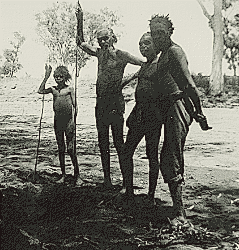
Spears were personal possessions of individual Aboriginal males.
The literal translation of the word 'Aborigine' is: the people who were
here from the beginning. It is not synonymous (doesn't have the same meaning),
as the word 'indigenous' as this means originating in an area (latin: indigena =
in (in) + ginere (be born) in a particular place.
There is no written record regarding prehistoric Aboriginal Australia. Knowledge of the past is found in archaeological evidence and Aboriginal oral traditions which have been handed down from generation to generation.
Therefore using reliable dates derived from archaeological evidence, theories of the initial colonization of Australia have been determined.
Prior to colonization which began in January 1788, the Australian Aborigines lived a lifestyle based on their Dreamtime beliefs. They had survived as a race for thousands of years and their lifestyle and cultural practices had remained virtually unchanged during that time. We refer to this as the traditional period.
However colonization imposed changes on the Aborigines as people who lived in areas that were being settled by the Europeans, were forced off their land as towns and farms were developed. We identify the period in which the changes took place, as the historical period. The sort of changes that took place usually commenced with explorers entering the area of a tribe and being challenged by the people for trespassing on their land. The Europeans often (usually) responded by shooting at the people. Many were killed. When settlers followed the explorers and began felling trees and building farms, they restricted the ability of the Aborigines to move freely around their land. They also destroyed their traditional food sources.
These changes took place throughout the continent at different times. They began in the Sydney and Parramatta districts from 1788; in the Cowpastures (Campbelltown / Camden)area from the early 1800s and in the Illawarra district from 1815. Gradually - but with increasing speed colonization spread throughout the entire continent.
The settlers had arrived in this country to build a new life for themselves and their families and had 'no time for the Dreamtime'. In other words most were not interested in the affects colonization was having on the Aborigines. In fact they were often considered to be a pest and a nuisance. Many were killed by diseases such as influenza. Thousands were massacred to make way for farms and settlements.
On the other hand some Aboriginal people adapted to the Whitman's laws and the new lifestyle. In doing so, many were reduced to pauperism and were beggars. Others broke the traditional tribal lore's by accepting Brass Plates and by moving into the traditionallands of other tribes. In many cases they had no option in doing this as they were facing starvation or the gun.
Overall, the Australian Aborigines went through stages of being conquered through an 'invasion' and taking of their lands. Many adapted to the new lifestyle (when many became reliant on alcohol, tobacco and handouts of food and clothing. However the settlers were often contemptuous of the Aborigines and separated them from their society and the people became the fringe dwellers of society. Others were removed from their families and placed into institutions. From the late 1830s the remnants of the tribes in the settled areas were moved onto Reserves and Missions where they were 'managed' by Whitemen and were forbidden from teaching their children their language and customs.
During the 1900s separation was an official government policy which lasted for many decades and today, many Aboriginal people do not know their origins. In other words, which tribe they are descended from or the names of their parents and or grandparents. They are a lost generation.
Australian Aborigines - the original inhabitants of the continent - are one of the best known and least understood people in the world. Since the nineteenth century they have been singled out as the world's most primitive culture and the living representatives of the ancestors of mankind. Aborigines are therefore probably more familiar to the rest of the world than are the white Australians who immigrated to the continent from Britain and other European countries. In reality, Aboriginal culture, as anthropological work over the last hundred years has revealed, is a complex, subtle, and rich way of life. On our way toward describing and understanding Aboriginal art, we need to look briefly at this culture, what it was in the past and what it has become today.
Aborigines have occupied Australia for at least forty thousand years. They came originally from southeast Asia, entering the continent from the north. (Present-day Australia, including Tasmania, was then one continent with what is now New Guinea.) Although Aborigines are Homo sapiens, biological isolation has meant that they are not racially closely related to any other people. Because of their relative cultural isolation, Aborigines were forced to develop their own solutions to the problems of human adaptation in the unique and harsh Australian environment. The result was a stable and efficient way of life. Probably because of its effectiveness, the society was slow to change, especially technologically. This gave to Aboriginal Australia the appearance of unchangingness. The archaeological record reveals, however, a number of innovations, among them the earliest known human cremations, some of the earliest rock art, and certainly the first boomerangs, ground axes, and grindstones in the world.
The stereotype of Aborigines passively succumbing to the dictates of their environment has also been recently questioned. We now know that they altered the landscape in significant ways, using what has been called "firestick farming" to control underbrush growth and to facilitate hunting. Aborigines also altered species occurrence of flora and fauna by resource management and possibly assisted in the extinction of prehistoric animals.
The notion of pristine natives with a "pure" culture was an artificial one - many Aborigines had considerable contact with Melanesians and Indonesians long before the European colonists arrived in Australia. Aboriginal groups also influenced each other. Waves of change swept the entire continent - changes in tools and implements, in social organisation, and in ceremonial practices and mythological concepts. Aboriginal culture was dynamic, not static. The Aboriginal culture of the last two hundred years, the period after the arrival of the colonists, has also been dynamic. This is why it is difficult to speak of a hard and fast dichotomy between Aborigines "before" and "after" contact with the Europeans. Nevertheless, it is useful to look at Aboriginal culture at the point of first contact and as it is today.
The population of Australia at the time of the arrival of the whites in 1788 was probably between 250,000 and 500,000. The pattern of Aboriginal settlement was like that for present-day Australians, except in the tropical north, with most of the population living along the coasts and rivers. Densities varied from one person for every thirty-five square miles in the arid regions to five to ten persons for every one square mile on the eastern coast. Residential groups ranged in size from ten to fifty people, with some temporary ceremonial gatherings reaching up to five hundred.
Most people tend to think of Aborigines as a unified, homogeneous group. Yet the Aborigines never used one collective term to describe themselves. No one individual Aborigine, in the precolonial past, would have known of the existence of many of the other Aboriginal peoples and regions of the vast continent of Australia, which covers nearly three million square miles - almost the area of the United States.
Recent scientific studies have concluded that the Australian Aborigines were the original Americans! In other words, the theory is that ATSI people were adventurers who arrived in the North American continent before the Vikings or Columbus. This theory states that the ancestors of the American Indians. are Aboriginal and Torres Strait Islander Australians. "Separate studies by both Brazilian and US scholars are revealing that the first humans to enter the New World more than 14,000 years ago were not Mongoloid peoples as has always been thought - but were instead people of the same race as present day Australian Aborigines."
APPEARANCE:
To the early Europeans, the Aborigines of the Sydney district (and later those throughout the whole continent), were primitives, natives or Noble Savages. So, descriptions of them (either written or in sketches/ paintings), were classificatory and comparative. There were a number of physical distinctions between different tribes. It was noted that the Gundungurra who lived in the Blue Mountains west of Camden were taller and stronger than the Eora / Dharawal who lived on the coast. Or so European observers said. Some tribespeople were said to be darker than others (dark brown or black) and were different in other ways, but anyone who indulges in descriptions should ask themselves why they are doing this. People are people and differences of color and shape shouldn't matter. However derogatory descriptions of Aborigines during the 19th century were often a justification for massacres and poisoning of people.

Spears were personal possessions of individual Aboriginal males.
Each tribe had their own particular style of spears. Basically, all spears were made from timber or from the stems of plants. They ranged in length from about 1.5 meters to 4 or 5 meters with various forms of points, tips or blades. Some spear tips were prongs which were used to catch fish; others were made from stone flakes while others were made from fish bones and shells. Spears were mainly used for hunting but they were also used in battles.
FOOD:
Hunting is a word that is used to identify the practice of catching and killing 'game' either as a sport or as a source of food. Gathering is the collecting of food such as plants, berries, eggs or insects. Fishing is another method of obtaining food.
The Aborigines who lived in areas which included waterways such as rivers or were on the seacoast, made canoes from bark or tree trunks.
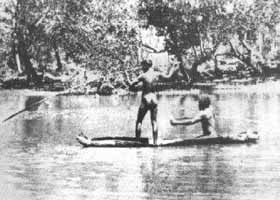
The Eora / Dharawal made canoes which carried up to three or four people. In other areas, the canoes were much larger and included dugouts and outrigger types. They were made from tree trunks (not just the bark).
Aboriginal men and women who lived in coastal regions or in areas where there were rivers, caught and collected food by fishing. Males usually used spears, while females used hand lines with hooks made from shells and rocks as sinkers. Fish species were also caught by the use of fish traps. Some traps were made from rocks in the form of a pen. At high tide fish could swim in and out of them, but some were trapped within the rock walls at low tide. Traps were also constructed from sticks and tree branches across rivers to make a dam. When sufficient numbers were trapped the people would enter the water, scoop up the fish in their hands and throw them onto the river bank to be collected for cooking.
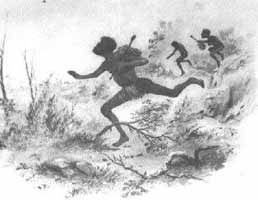
Males hunted animals such as kangaroos, wallabies, echidnas and possums. But also reptiles (snakes and lizards) and birds such as ducks, swans and parrots. They used spears and boomerangs to hit, catch and kill - but also climbed trees to get their food. Sometimes they hunted in parties or groups and each person shared the catch. On these occasions some of the men acted as 'beaters' driving animals towards another group of men who were armed and waiting to spear the animals that were driven towards them. Sometimes they used fire to drive the animals forward.
Aboriginal woman (often carrying babies on their backs) and assisted by young children left the camp on a daily basis searching and collecting berries, yams and other sources of food.
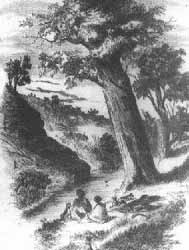
Some writers have suggested that 'gathering' provided the bulk or main source of food for the Australian Aborigines. It has also been said that some tribes people were mainly 'vegetarians' because 'meat' was not readily available in some areas. It is also a fact that some Aboriginal people ate more marine life (fish, oysters and mussels etc) because these food items were predominant in the area in which they lived.
Survival was highly dependent upon knowledge of the life-cycle of flora and fauna and it is certain that the Aborigines had excellent understanding as they learned to track, hunt and gather food from when they were young children.
In 1972 Australian Anthropologist, Kenneth Maddock,said: "Australia is the only continent to have been populated until modern times exclusively by hunters and gatherers..." (The Australian Aborigines. A Portrait of their society). He also quoted statistics showing that in 10,000 BC all human beings (100%) were hunters and gatherers; by 1,500 AD this had reduced to about 1% because mankind had generally developed skills in the cultivation of crops and domestication of animals. By 1960 only 0.001% of the world's population were hunters and gatherers.
The fact that the Australian Aborigines did not cultivate land to grow crops or domesticate animals, they have often been portrayed as being a backward race.
However this can be disputed. After all, the Aborigines did harvest crops in the sense that they made a form of flour from various types of flora. Domestication of animals was not possible due to the type (or perhaps kind) of animals that roamed the continent of Australia. For example kangaroos, wombats, possums and snakes.
Sheep and cow were introduced by Europeans. But there is evidence to suggest that the Aborigines of the Cowpastures district (Campbelltown area) herded and killed cattle that had escaped from the Port Jackson area circa 1788 and found there way to that area.
These cattle had been transported from Africa and before vandals destroyed it, there was a cave in the Campbelltown area that was called Bull Cave, because of the drawings of cattle on the walls.
Those Aborigines who lived in coastal regions or near waterways caught fish and eels in a number of ways. Males often used a spear but are known to have also built fish-traps by making rectangular areas with rocks, that stood above the water at low tide. This meant that fish could swim into the traps at high tide and were trapped as the tide receded.
In the Illawarra district the Aborigines were often observed barricading (blocking) rivers with tree branches and logs. As fish swam down the river towards the sea they were trapped behind the dam where they were scooped up and thrown onto the shore. The Aborigines also fished from rocks and beaches using hand lines made from plants and hooks made from shells. Stones were used as sinkers.
Aboriginal people had to catch and collect their food, each and every day of their life. They were successful at doing this because they had an intimate knowledge of food-chain cycles, the migration patterns of birds and of the habitat where they lived. No doubt there were times when there were food shortages. But the essential point is that the Aboriginal people had a complete understanding of the flora and fauna within their tribal territory. They also engaged in land management practices - mainly burning grass and weeds.
Their totemic practices protected species because a person could not eat his own totem and others needed permission to catch another person's totem on his land. For example, a man whose totem was a waterfowl would not eat that bird (otherwise it would be a form of cannibalism). Other members of the tribe could not hunt the bird in the territory that belonged to another man. This provided a safe environment for different species.
GOVERNMENT:
In Aboriginal society every person (particular every initiated male) was considered to be equal. No one had authority over anyone else in the sense of ruling them, but this is not to say that there weren't leaders. There are always leaders in any society - people who have personal qualities that others admire. But there were no elected leaders in Aboriginal society. There were also people who performed particular roles. For example clever men also known as Koradjis and as Doctors by Europeans, had or acquired special skills and were considered to be authorities on certain matters.
There were leaders known as Elders. People whom others listened to, asked for advice and generally obeyed when they issued orders. The Elders were considered to be wise in knowledge of the Dreamtime the law and the lore's of the tribe. An Elder was usually a male but gray hair and old age were not the only criteria to be an Elders. In fact some elderly people were not considered to be Elders.
To understand the role of the Elders it is necessary to understand that the Aborigines lived in small family groups also known as clans, bands and sub-tribes. Within the immediate family groups, the eldest males and females were treated with respect and acknowledged as leaders in the sense that they made decisions about the family. For example they settled disputes and decided when the group would move camp to another area. When a number of blood-line families lived together it is likely that the Elder of the group was the person considered by the members to be the wisest of the older people.
In large groups which may have been comprised of several hundred people, a number of Elders met to make decisions on behalf of the group. This has become known as an Elder's Council, but it wasn't a council in the sense of being a form of government. Instead such councils met for the purpose of conducting initiation, marriage and burial ceremonies
In traditional Aboriginal society females were not considered to be Elders. However, older females often acted as midwives and as authorities on other matters relevant to their gender. The role of female Elders today, as spokespersons for groups, appears to be a phenomena of the 20th century.
LAW:
The Aborigines had a number of laws that governed their society. They ranged from family discipline (whereby children and others were expected to conform and behave to a code of conduct) to laws about trespassing, food taboos, marriage laws or regulations and breaches of acceptable behavior such as rape, murder and stealing.
The source of the laws were Dreamtime stories that told of the behavior of men, woman and children (sometimes in allegorical forms of animals, birds or reptiles - etc. in which the perpetrators actions were punished by being beaten, speared or by banishment.
SOCIAL STRUCTURE:
Aboriginal Australians were social beings who lived in a number of social groups sometimes called bands, clans, sub-tribes and tribes, but essentially in a family or kinship group who were 1) of the same blood-line and 2) were related to other people through totems.
The social groupings of ATSI people meant that their relationships were far more extensive than our own method of identifying people as mother, father, brother, sister and cousins (etc). Aboriginal relationships are difficult to understand but the relationships of an Aboriginal male child are detailed in following script (with western ones shown in brackets), to give some idea of them: The family was usually comprised of father's father (grandfather) and often his brother or brothers who was / were known also known as father's father (no western equivalent); his wife or wives (grandmother); a father (father) and perhaps his brothers (uncles) who was also considered to be an Aboriginal male child's father.
Each family group had a headman or Elder who was the leader of the unit. He decided when to move camp and settled disputes
Food such as oysters, mussels and pippies were enjoyed. Sometimes they cooked them on the ashes of a fire and the Sydney Aborigines are known to have taken a fire with them aboard their canoes when they went fishing. This meant they could cook and eat their catch as they continued catching fish. They also took some of their catch back to the camp to share with others, but eating food while catching it gave them the energy to collect sufficient quantity for others.
Animals, birds and reptiles were also caught and cooked on an open fire. However they 'scorched' rather than cooked these foods. In other words, they did not roast the joint of a kangaroo like Europeans do today. For example by placing a leg of lamb in an oven for an hour or two. The Aborigines simply singed the food to remove feathers, scales and fur and ate partly cooked meat.
Other sources of food included yams (sweet potatoes), berries and intestines such as liver (yuck). But they generally hunted and collected the wide variety of food that was available in the places in which they lived.
One food that was cooked by the Aborigines was a type of bread which was also popular among early European settlers who called it damper. This is made by grinding seeds into flour, mixing this with water into a doughy paste and cooking it in the ashes of a warm fire.
The Aborigines lived within a tribal territory where they obtained their daily food needs. Some tribes lived in desert country, while others lived in mountain, coastal or timbered areas. This meant that the members of different tribes ate different foods. It also meant that some of them were constantly on the move hunting and gathering. Others lived a semi-nomadic life in areas where there were amply food supplies.
The Eora / Dharawal people who lived on the coastal area between the Hawkesbury River and the Shoalhaven River were hunters and gatherers of fish, shellfish, plants and animals. They caught fish such as bream, groper, snapper and whiting; collected shellfish including oysters (rock and mud), cockles and conniwink.
Plant foods included: native cherries, the cabbage palm, water lilies, five-corners and pigface. Animals, birds and reptiles such as kangaroos, ducks and snakes were also hunted for consumption purposes.
MARRIAGE:
Every tribe in Australia was divided into a number of small social groups, but for marriage purposes, into two main groups sometimes called marriage moieties.
People didn't marry outside of their group.
Marriage arrangements were made when children were very young and even before they were born.
HOMES:
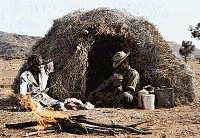
Aboriginal people were social beings as they lived and gathered together in family groups . Their camps were comprised of a number of gunyas (bark huts), but the people also lived in caves or in the open air. Some camps were comprised of as few as 6 to 10 people while in others there were up to 400 people. No doubt the availability of food was a factor in the size of a camp. Each day, various members of the group would leave the camp to hunt and gather food and return to the camp to share the catch with others.
During the 1830s William Govett (surveyor), visited a camp and recorded (in Sketches of New South Wales), that the people usually settled in their camp as night fell and were engaged in a number of activities - normal family life - sharing stories about the happenings of the day, repairing weapons, singing songs and playing games etc. Govett described a young man in one gunya using double sets of strings to make diamonds, squares, circles and other shapes. He also told of an adult amusing a young child by placing a leaf on the back of his left hand, striking it with his finger causing the leaf to ascend perpendicularly to the squeals of delight from the child.
Aboriginal people lived in family groups. The Elder or Elders gunyah (hut) were situated in the center of the camp and others spanned out in circles around the central hut. However, the people often slept in the open and in caves, so it is likely that the Elder decided where he wanted to sleep with his wife or wives and everyone one else spread-out from the spot he had chosen. No doubt some people were more important than others and the most important ones camped near the Elders.
LAND:
The affinity of attachment to a particular area of land by the Aborigines was based on their Dreamtime beliefs, that the land had been created for them by ancestral heroes and heroines. Every rock, tree and waterhole; every animal, bird and insect; the sky above and all it contained were believed to have been created in the Dreamtime.
At some indefinite time the creators disappeared, however, many were believed to have remained in secret places in the land - in rivers, caves and other places. In other words, the Aborigines believed that their land had been created by spirits who continued to live in the land.
This was a superstitious belief, but it was very important to the Aborigines. For example, there were never any wars of conquest between Aboriginal tribes. They were too superstitious to do this and living in the land of another tribe would have involved them in living among strange and no doubt hostile spirits.
Land was spiritual, but also an economic resource as it provided the people with food, sources of wood, fiber and glue for making spears, utensils and other implements. However the people respected these aspects of their land and were environmentalists in the sense of 'taking care' of the land through their practices of performing increase ceremonies, singing 'Songlines' and relationships with flora and fauna through a system of totemic relationships.
Traditional Aboriginal people (before their society was changed with the arrival of the British into their lands), lived in relatively small groups which have been called clans, bands, family groups, sub-tribes and by a variety of other names.
The larger (well known term) social unit known as a tribe, was made up of a number of smaller social units (clans and bands etc). Maybe we can explain it this way: A clan was a family group made up of a grandfather and his wife or wives, his sons and their wife or wives and their children. A number of these groups formed a tribe. The exact number of clans which comprised a tribe cannot be said precisely, as this varied. However in the Sydney district it is known that in 1788 there were at least 30 clans of the Eora / Dharawal tribe. Each clan had a name for themselves based on the name in their language for the area they lived in. For example the men of Cadi were known as the Cadigal (Cadjigal) females added the postfix eean so the women from Cadi were the Cadieean and they lived around South Head, Elizabeth Bay, Rushcutters Bay to present day Circular Quay. The Gweagal / Gweaeean lived at Kurnell.
The clans which formed a tribe were those who believed in the same Dreamtime creation stories, spoke the same language and celebrated the same customs such as initiation rites.
The Aboriginal people of the Sydney, Illawarra and Shoalhaven district (and most, if not in all parts of Australia), were often observed by early settlers to be naked. The men and women of some tribes are known to have worn a belt around their middle made of hair, animal fur, skin or fiber which they used to carry tools and weapons.
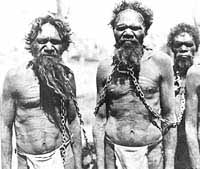
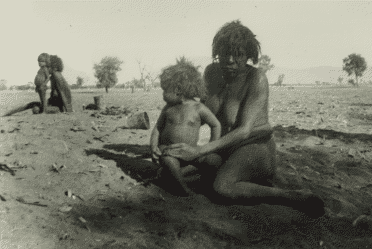
These belts often had a flap at the front, however, this was a modification that was added during European colonization when the British colonists and authorities were concerned about modesty and imposed their standards on the Aborigines - who were unashamed of their nakedness. However, Aboriginal people needed to be warm in winter months and did make cloaks which they made from animal skins e.g.., possum skins. They worn them during the day and used them as blankets during the night. A number of skins were needed to make the garment and they were cleaned, dried and sewn together.
During colonization individual settlers gave the Aborigines their old clothes (known as slops). So the people were often recorded as wearing a variety of clothes such as army or navy jackets, trousers, petticoats and blouses (etc).
From the 1830's a number of Governors issued English blankets to the Aborigines through Magistrates and well respected settlers in various parts of the country. The blankets were not as warm as possums skin cloaks and many Aborigines caught influenza and bronchitis and died from these diseases.
DANCE:
The Aborigines did not dance. They held corroborees in which there were elements of music, song and movement that imitated or replicated animal movements, hunting prowess, battles or ceremonies of initiation that had been conducted for thousands of years. Corroborees are part of Aboriginal culture. They were not simply dances, but were highly significant events and belong to the Australian Aborigines.
MUSIC:
The Australian Aborigines used a limited variety of implements to make musical sounds. The didgeridoo (see separate listing) is probably the best known, but others included rattles, clapping sticks and two boomerangs clapped together. However they do not appear to have used drums. The exception may be the Torres Strait Islander people. Another instrument that wasn't used, was a flute or whistle.
The melodies, tunes, harmonies and rhythms of Aboriginal music included traditional ceremonial songs that were handed down from generation to generation. It was very important in Aboriginal thinking, to replicate the songs that had been first played and sung by the ancestors in the Dreamtime. When the traditional music and songs were used, living men considered themselves to be in the Dreamtime. Particularly during initiation ceremonies.
However 'new songs' were created from time to time. They told of important events in the history of the tribe. Events such as great battles or hunting expeditions. Other songs and music were for general amusement or entertainment and early European observations of the Aborigines included camp life where the people played games and sang songs around their camp fires.
PART 2
AUSTRALIA INDEX ANCIENT AND LOST CIVILIZATIONS ALPHABETICAL INDEX OF ALL FILES CRYSTALINKS MAIN PAGE